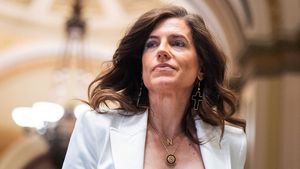A new mural in Baltimore pays tribute to the late drag actor and cult figure Divine, but it was also meant to celebrate and show support for the LGBTQ community and "queer history" of his hometown, according to the two men who commissioned it.
I'm So Beautiful is the title of the piece, painted by the internationally prominent street artist Gaia, also known as Andrew Pisacane. Depicting a benevolent Divine, with eyebrows arched and lips pouting, it's based on the Greg Gorman photograph used in the cover art that accompanied the release of Divine's 1984 disco single, "I'm So Beautiful."
The three-story-high mural is the first work of public art in Baltimore to commemorate Divine, who became famous starring in John Waters movies including Hairspray and Pink Flamingos and was who was once dubbed "Drag Queen of the Century" by People. It's one of the first murals anywhere to pay tribute to a drag queen.
The mural was painted on the side of a row house at 106 E. Preston St. in the Mount Vernon historic district, which for years has been Baltimore's "gayborhood." It's six blocks from the corner where Waters filmed his notorious scene in which Divine eats actual dog feces at the end of Pink Flamingos.

Jesse Salazar and Tom Williams
The mural was commissioned and funded by Jesse Salazar, 35, and Tom Williams, 37, a married couple who bought the house as an investment property several years ago. Longtime fans of Divine, they say they commissioned the mural because they wanted both to honor him and to send a message with their art.
"My husband and I asked Gaia to create this mural as a tribute to Divine and the city's queer history," Salazar said. "At a time when LGBT rights are being threatened, we hoped that Divine's beauty would inspire others to know that they too are beautiful."
The owners wanted to reproduce the image from the "I'm So Beautiful" cover, Salazar said, because they felt it best captured the message they wanted to convey.
"There are many amazing images of Divine, but this iconic image by Greg Gorman felt truly inspirational," Salazar said. "In it, Divine is portrayed like a hero, and it triumphantly speaks to self-esteem and seeing oneself as beautiful. We also felt it sends a positive message about the city's queer history and the city's own pride in itself."

John Waters
Divine, also known as Harris Glenn Milstead, was born in Maryland in 1945 and died of an enlarged heart in 1988, just after Hairspray was released. Although he rose to fame in John Waters movies, before his death he was branching out into other fields, including acting on television and singing. Waters, who gave Divine his drag name and had been friends with him since high school, was one of the first Baltimoreans to visit the mural, painted over an eight-day period in October.
"It is great," Waters, 72, said in an email. "Divine looking out, blessing the city."
Baltimore Magazine editor in chief Max Weiss is another fan of the mural (or, as some Baltimoreans pronounce it, Muriel, hon).
"I predict that this will become the most photographed mural in the city," Weiss wrote on Facebook.
Gaia lives in Baltimore, graduated from the Maryland Institute College of Art, and has painted murals around the world, including in London, Rome, Cape Town, Buenos Aires, Bogota, and Perth. He said he admires Waters and was happy to execute the owners' vision.
"I like to paint very graphic images, very bold, saturated colors," he said. "This fi t... my aesthetic."
There have been other efforts to create a monument that honors Divine in his hometown, including a $70,000 sculpture complete with a replica of dog droppings, at the corner near where Divine filmed the infamous scene in Pink Flamingos. The American Visionary Arts Museum, in Baltimore's Inner Harbor, has a 10-foot-tall statue of Divine in its collection.
Ryan Patterson, the public arts administrator for the Baltimore Office of Promotion and the Arts, said he can think of three or four efforts to commemorate Divine with public art over the past five years, but I'm So Beautiful is the first Divine-related work to be completed outside a museum setting.
Salazar and Williams said they have never commissioned a work of art before and have never met Waters or Divine. But they wanted to add a work of art to their building and had no other subject in mind but Divine.
"Divine symbolizes what we love about Baltimore, so we didn't really consider anything else," Salazar said.
Salazar is from Dalton, Pa., a small town near Scranton. Williams is from the south shore in Massachusetts. Both lived in Washington, D.C., before moving to Baltimore.
Salazar and Williams met at an inauguration party in Washington for Barack Obama. They have been together for almost nine years and got married last July.
In an interview, Salazar declined to disclose what he and Williams do for a living or how much the mural cost. He said they live two and a half blocks from the Preston Street building and purchased it to operate as an Airbnb property. The building is close to Pennsylvania Station, a stop on Amtrak's Northeast Corridor route, and all the attractions in Mount Vernon, such as the Walters Art Museum and Peabody Institute. The previous owners had operated a bed-and-breakfast there called Aunt Rebecca's.

Gaia
Salazar and Williams asked Gaia to paint the mural they had in mind after seeing ones he painted for Lady J (a friend of theirs) in Baltimore's Remington neighborhood.
"We met Gaia at Lady J's house, literally while he was painting," Salazar said. "We had both been thinking about the power of [Gorman's] image, but it was just an idea until we saw Gaia painting. When we saw how powerful of an artist he is, we knew that he'd be able to make it a reality."
Gaia initially warned the two men he wouldn't be able to paint the Divine mural until the spring of 2019 because of a busy schedule, but then a week opened up on his calendar. Salazar said he paid for the work by taking out a loan on his credit card. The artist and his crew began work October 15, four days before Divine's birthday.
As a gay man, Salazar said, he hoped the mural would make a positive statement about the LGBTQ community at a time when people's rights are coming under attack, including the plan to "erase" transgender people by narrowing the way the government defines gender.
"I'm sincere in saying the message is really important right now," he said. "I thought it would be a positive expression of our history and importance to the city.
"I'm queer," he continued. "I know that being queer sometimes can be lonely. I want people to know that they are beautiful. It's that simple to me. We have to pay it forward. There is a discussion now about transgender people being erased. I think the mural is particularly important in that context."
In Waters's movies, Divine typically played lovable lawbreakers. As Dawn Davenport in Female Trouble, he was a murderer who died in the electric chair. In Multiple Maniacs, he was Lady Divine, who kills her boyfriend and eats his heart.
The Divine mural isn't entirely legal, either. According to Eric Holcomb, the head of Baltimore's Commission for Historical and Architectural Preservation, it was painted without any permits, which are required for any changes to exteriors of buildings in the Mount Vernon historic district. The commission has asked the owners to apply for an "authorization to proceed" notice to make the mural legal, Holcomb said.
Salazar and Williams have submitted the application, which is under review, and the mural is allowed to stay up until a decision is made. The owners have also asked experts to weigh in on the quality and significance of Gaia's mural in letters to the preservation commission. A public hearing has been scheduled for November 13.
"As a work of art, this particular mural of Divine is astonishing for its sensitive likeness, bold color, excellent execution, and brilliant physical placement, poking out from the alley amongst stately row houses," wrote Christian Larsen, associate curator of modern and contemporary art at New York's Metropolitan Museum of Art.
Noah Brodie, the chief executive officer of Divine's estate, also supports keeping the mural.
"It's an inspiring message for counterculture types, the LGBT community, and those affirming body-positive representation," Brodie said in his letter to the commission. "In many ways, [Divine] represents the strength of Baltimore's character, and serves as a reminder of the city's perseverance and authenticity. Divine is brassy, bold and beautiful, just like Baltimore."
Salazar and Williams are hopeful the mural can stay.
"We are honored to contribute this tribute to a treasured icon and our city's LGBT history," Salazar said. "It brings us immeasurable joy to know that the city is enjoying the mural and its positive message."





















































































